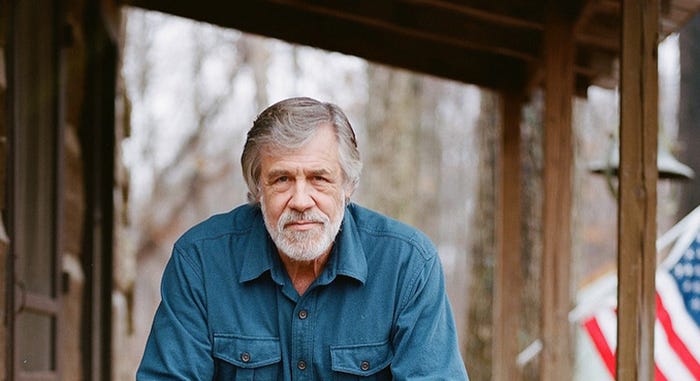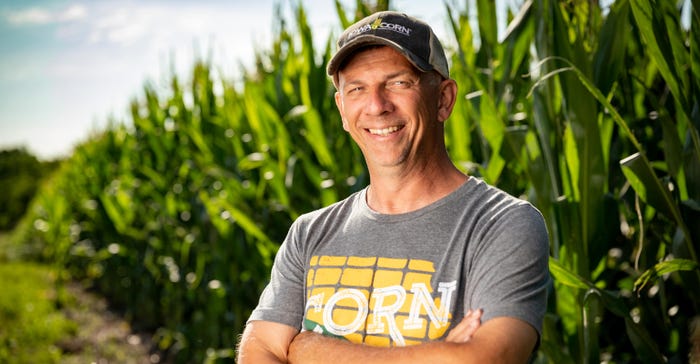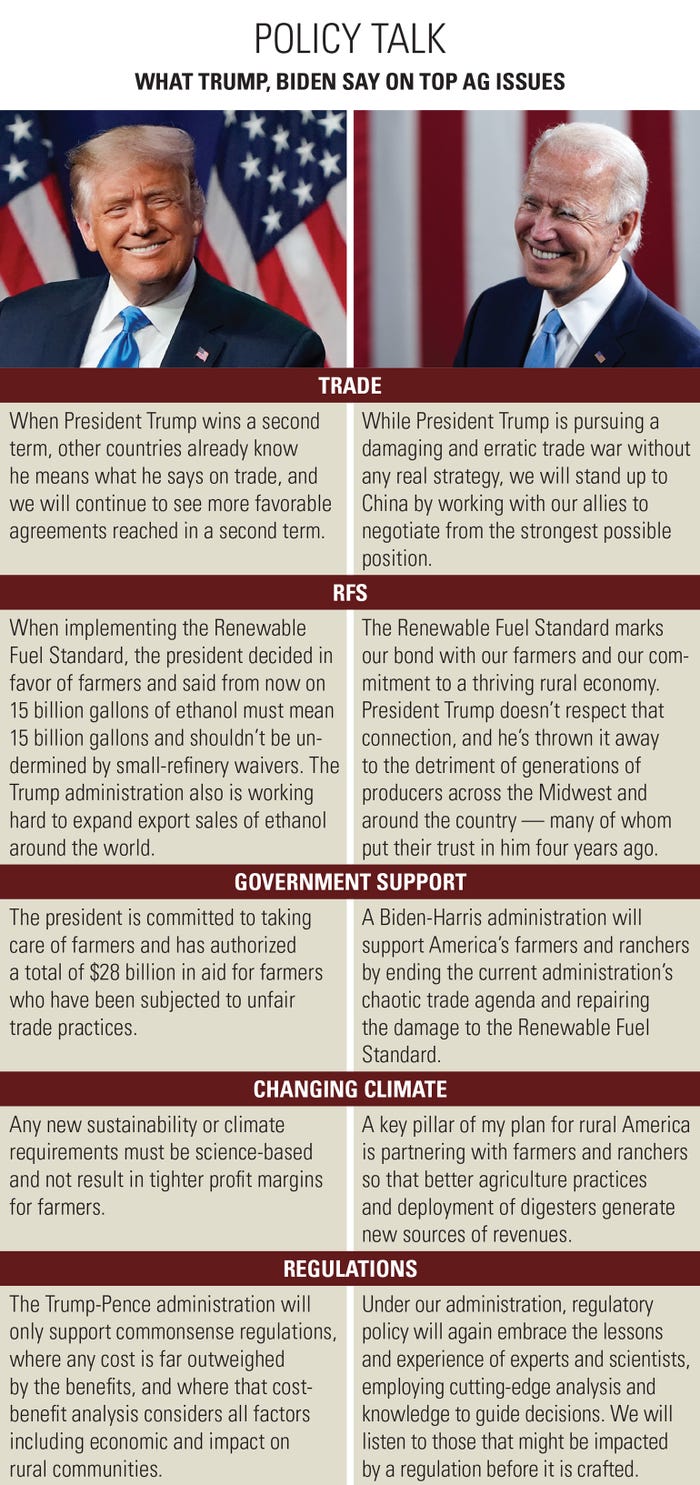
There’s a story that’s often shared about Sonny Perdue’s first days as secretary of agriculture, when he talked President Donald Trump out of withdrawing from NAFTA by showing him a map of the electoral red and blue states, and reminded him of all those red states in the middle — the people who landed him in office.
Trump hasn’t forgotten, voicing his affection for the rural vote time and again these past four years.
In 2016, Trump won the rural vote by 33 points — 64% compared to Hillary Clinton’s 31%. And he won the White House despite losing the popular vote. In battleground states such as Pennsylvania, Michigan and Wisconsin, Trump’s advantage with rural voters pushed him narrowly over the edge on total votes in the state to secure those electoral votes.
Jay Armstrong, a Kansas farmer and member of the Farmers & Ranchers for Trump Coalition, says that story about Perdue showing Trump those red states continues to remind him that the president recognized his base. And listened.
“And he hasn’t forgotten us,” he adds.
Armstrong, who farms 3,000 acres of corn, soybeans and wheat in northeastern Kansas near Atchinson, says he’s seen Trump take on China and fight for better trade deals for farmers and turn the economy around. And at the same time fight a lot of battles that were “purely political.”
“Lesser men would have given up. You just get a sense of pride in somebody like this,” Armstrong says. “His ways are maybe not my ways, but his results are certainly my results.”
Armstrong is not alone in deep admiration for Trump’s administration in taking on burdensome regulations and not backing down in attempts to level the trade playing field. Our August survey found 75% of farmers would vote for Trump, a nearly identical response to the same question we posed in 2016.
Trump’s trade wars and lower commodity prices may have led to the slightly lower support for him
at 60% in 2018 and 66% in 2019. But as Armstrong says, he saw many conservative farmers who were on the fence over supporting Trump turn 180 degrees in recent months.
Rural voters felt forgotten by presidential candidates — until Trump came along.
“They know he’s behind farmers, not anti-farmers, or neglecting farmers. He gave us money to keep us propped up,” Armstrong says of recent trade aid.
Too much help?
In swing state Ohio, farmer Chris Gibbs is not so sure all that government aid helps farmers.
The only thing that has kept farmers afloat since the Trump administration started a war on trade back in 2018 has been influxes from the U.S. Treasury Department, with trade mitigation payments of $12 billion in 2018, $16 billion in 2019, $19 billion at the start of 2020 and now at least $10 billion more for coronavirus relief assistance, he says.
“In my state, I see farmers deeply in debt and increasingly reliant on federal government subsidies,” says Gibbs, a grain and cattle producer. “While he talks a good game, Donald Trump’s vision for agriculture doesn’t seem to offer any change to these trends.”

Since voting for Trump in 2016, Gibbs has stepped down as chairman of his local GOP, ran briefly as an independent candidate for Congress and became an outspoken critic of Trump’s ag policies. He now serves as a chairman of Rural America 2020, a grassroots effort to elevate the discussion on how political decisions impact farmers.
“The president continues to tell me that I’m a patriot for taking one for the team. That’s an insult,” Gibbs says. “Making sure my farm is viable — and I continue to produce for my family, my local community, my hardware store, my fix-it shop and my local schools through property taxes — that’s what makes me a patriot, not going out of business.”
Gibbs says he voted for Trump in 2016 because he promised a new way of doing business. “And I bit on that. Now I’ve got reservations. I’ll be voting for Joe Biden in the fall.”
Following an Aug. 13 speech by Vice President Mike Pence in Iowa just three days after the derecho storm demolished hundreds of miles of corn and soybean fields, Vinton, Iowa, farmer Lance Lillibridge said farmers needed “more than a campaign speech right now,” as farmers are at their wit’s end.
Stumble over ethanol
If Trump is vulnerable in farm country, it could be because he is trying to appease both his oil and ethanol friends.
Armstrong says asking Trump to choose between friends — either the oil or ag sector — could be considered political extortion. “In politics, nobody gets everything they want. To ask a man that’s good to choose between energy or ag really is not fair.
“Corn farmers better understand they no longer produce corn for a commodity market, but a political market,” Armstrong says. “The use of corn now is set by political policy and not supply and demand. Now, start learning the consequences.”

Lillibridge, who farms 1,600 acres of corn, soybeans and alfalfa hay, says the uncertainty facing his operation has been larger than it’s ever been. It hasn’t always been easy, with 2008’s historic floods, 2011’s damaging winds and 2012’s drought. But he says he persevered and came out on the other end stronger because of the ethanol industry and trade.
Now, like so many voters, he is on the fence about the November election. “I’m not sure we can afford four more years,” he says. “But I’m not sure if it goes the other way, we can afford that either.”
Decision time
The crux of the rural vote lies in that question: Will farmers stick with Trump for four more years, or look to Democratic candidate Joe Biden to rectify what farmers see as Trump’s flaws? And if they remain loyal to Trump, will he return the sentiment after Nov. 3 if he wins?
After the 2016 election and poor showing by Democrats in rural America, several Democrat-leaning groups sprang up. After losing her reelection bid, former U.S. Sen. Heidi Heitkamp of North Dakota used leftover campaign cash to start One Country Project to not only help the Democratic Party better understand the needs of rural America, but also help rural America understand what the party stands for with its platform.
“I think elections are always won in the middle,” she says. “You take the hard-core Republican support, which has now become hard-core Trump support, and then the reliable Democratic base, and everybody is focused on motivating their base. Elections are always won by persuading those people who are not particularly ideological on either side that you have better ideas for running the country.”
Former Iowa Lt. Gov. Patty Judge started another group — Focus on Rural America — to help educate the Democratic Party on the importance of rural issues. One of its first undertakings was to hold focus groups in Midwest states such as Iowa that voted twice for Barack Obama but lost by big margins in 2016.
The group’s research found that Trump came into the 2016 election and talked about change, making things better and shaking up the status quo. Yet, Judge says those who chose to vote for Trump did so very late in that election cycle.
Judge says voters are faced with deciding whether Trump has delivered or not. “Did he bring that change that he promised us, or did he leave us hanging out to dry? It’s my belief we have been left behind.”
Focus on Rural America also helped educate the pool of 27 initial Democratic presidential nominees who came to Iowa ahead of the caucuses with a varying degree of understanding about rural issues. Nominees had to realize they didn’t need to come to Iowa and have a photo op of milking a cow, but instead needed to understand the rural economy, visit an ethanol plant, and start to recognize the importance of value-added agriculture and good-paying jobs, Judge says.
She thinks Democrats have an opportunity to flip Wisconsin back to blue, as well as Pennsylvania and Michigan. She’s also confident Minnesota will stay blue. Iowa has gone back and forth between swing state and solid red, but Judge also indicates some recent polling from her organization shows Iowa remains too close to call.
Political analyst Tim Marema, editor of the Daily Yonder, published by the nonprofit, nonpartisan Center for Rural Strategies, says the rural vote will always play a critical role in the closer elections. “Democrats don’t have to win in rural areas to come out on top nationally, but they’ve got to cut that margin way below 33 percentage points to come out ahead in the final results.”
Marema notes Republicans have an advantage in many parts of rural America. “If Democrats want to have a rural strategy, and there’s some evidence that they do, it’s got to be that you soften the margins and limit the losses that you have in rural areas,” he says. “If Democrats can get it down to 10 or 12 points, as Obama did, that’s the place a Democrat would need to be in rural America to have the margins to win at the national level.”
Armstrong says Biden is often lumped in with the extreme socialist views of Sens. Bernie Sanders and Elizabeth Warren, who just “scare people to death” in rural America. He adds nobody “out here” likes House Speaker Nancy Pelosi and Senate Minority Leader Chuck Schumer.
Instead, farmers want someone to stand up for their beliefs.
In 2008, Republican candidate Sen. John McCain won the rural vote by 12% and 2012 candidate Mitt Romney increased that to 19% — but Barack Obama still won the presidency. Armstrong says those Obama-year losses were directly related to seeing those Republican candidates as unpassionate, especially when it comes to fighting on behalf of farmers.
“Romney and McCain would never get in the ring and fight and counterpunch the way Donald Trump does. That’s what finally motivated so many to go vote,” Armstrong says. “While Trump’s style may be offensive to suburban housewives, if you have ever negotiated for a piece of land or equipment, it’s quite identifiable. It is not offensive to the fella who’s out here.

About the Author(s)
You May Also Like






